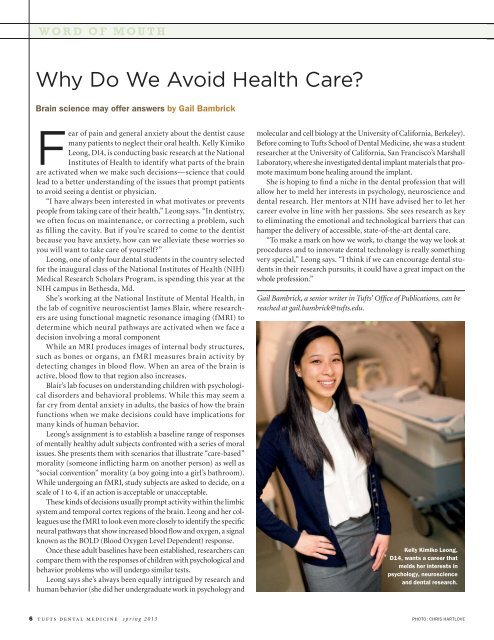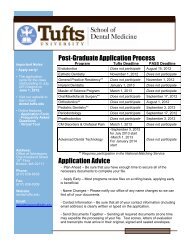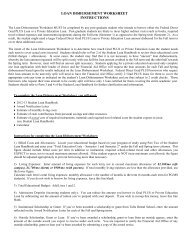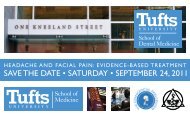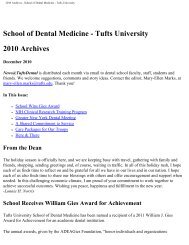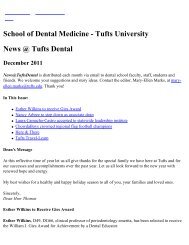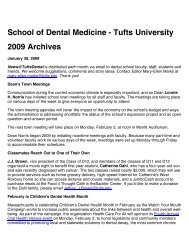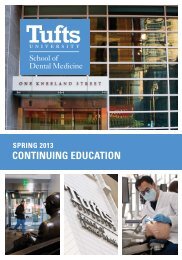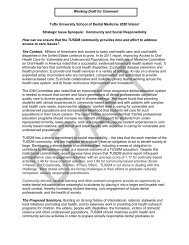Spring 2013 - Tufts University School of Dental Medicine
Spring 2013 - Tufts University School of Dental Medicine
Spring 2013 - Tufts University School of Dental Medicine
You also want an ePaper? Increase the reach of your titles
YUMPU automatically turns print PDFs into web optimized ePapers that Google loves.
word <strong>of</strong> mouth<br />
Why Do We Avoid Health Care<br />
Brain science may <strong>of</strong>fer answers by Gail Bambrick<br />
ear <strong>of</strong> pain and general anxiety about the dentist cause<br />
many patients to neglect their oral health. Kelly Kimiko<br />
Leong, D14, is conducting basic research at the National<br />
Institutes <strong>of</strong> Health to identify what parts <strong>of</strong> the brain<br />
are activated when we make such decisions—science that could<br />
lead to a better understanding <strong>of</strong> the issues that prompt patients<br />
to avoid seeing a dentist or physician.<br />
“I have always been interested in what motivates or prevents<br />
people from taking care <strong>of</strong> their health,” Leong says. “In dentistry,<br />
we <strong>of</strong>ten focus on maintenance, or correcting a problem, such<br />
as filling the cavity. But if you’re scared to come to the dentist<br />
because you have anxiety, how can we alleviate these worries so<br />
you will want to take care <strong>of</strong> yourself”<br />
Leong, one <strong>of</strong> only four dental students in the country selected<br />
for the inaugural class <strong>of</strong> the National Institutes <strong>of</strong> Health (NIH)<br />
Medical Research Scholars Program, is spending this year at the<br />
NIH campus in Bethesda, Md.<br />
She’s working at the National Institute <strong>of</strong> Mental Health, in<br />
the lab <strong>of</strong> cognitive neuroscientist James Blair, where researchers<br />
are using functional magnetic resonance imaging (fMRI) to<br />
determine which neural pathways are activated when we face a<br />
decision involving a moral component<br />
While an MRI produces images <strong>of</strong> internal body structures,<br />
such as bones or organs, an fMRI measures brain activity by<br />
detecting changes in blood flow. When an area <strong>of</strong> the brain is<br />
active, blood flow to that region also increases.<br />
Blair’s lab focuses on understanding children with psychological<br />
disorders and behavioral problems. While this may seem a<br />
far cry from dental anxiety in adults, the basics <strong>of</strong> how the brain<br />
functions when we make decisions could have implications for<br />
many kinds <strong>of</strong> human behavior.<br />
Leong’s assignment is to establish a baseline range <strong>of</strong> responses<br />
<strong>of</strong> mentally healthy adult subjects confronted with a series <strong>of</strong> moral<br />
issues. She presents them with scenarios that illustrate “care-based”<br />
morality (someone inflicting harm on another person) as well as<br />
“social convention” morality (a boy going into a girl’s bathroom).<br />
While undergoing an fMRI, study subjects are asked to decide, on a<br />
scale <strong>of</strong> 1 to 4, if an action is acceptable or unacceptable.<br />
These kinds <strong>of</strong> decisions usually prompt activity within the limbic<br />
system and temporal cortex regions <strong>of</strong> the brain. Leong and her colleagues<br />
use the fMRI to look even more closely to identify the specific<br />
neural pathways that show increased blood flow and oxygen, a signal<br />
known as the BOLD (Blood Oxygen Level Dependent) response.<br />
Once these adult baselines have been established, researchers can<br />
compare them with the responses <strong>of</strong> children with psychological and<br />
behavior problems who will undergo similar tests.<br />
Leong says she’s always been equally intrigued by research and<br />
human behavior (she did her undergraduate work in psychology and<br />
molecular and cell biology at the <strong>University</strong> <strong>of</strong> California, Berkeley).<br />
Before coming to <strong>Tufts</strong> <strong>School</strong> <strong>of</strong> <strong>Dental</strong> <strong>Medicine</strong>, she was a student<br />
researcher at the <strong>University</strong> <strong>of</strong> California, San Francisco’s Marshall<br />
Laboratory, where she investigated dental implant materials that promote<br />
maximum bone healing around the implant.<br />
She is hoping to find a niche in the dental pr<strong>of</strong>ession that will<br />
allow her to meld her interests in psychology, neuroscience and<br />
dental research. Her mentors at NIH have advised her to let her<br />
career evolve in line with her passions. She sees research as key<br />
to eliminating the emotional and technological barriers that can<br />
hamper the delivery <strong>of</strong> accessible, state-<strong>of</strong>-the-art dental care.<br />
“To make a mark on how we work, to change the way we look at<br />
procedures and to innovate dental technology is really something<br />
very special,” Leong says. “I think if we can encourage dental students<br />
in their research pursuits, it could have a great impact on the<br />
whole pr<strong>of</strong>ession.”<br />
Gail Bambrick, a senior writer in <strong>Tufts</strong>’ Office <strong>of</strong> Publications, can be<br />
reached at gail.bambrick@tufts.edu.<br />
Kelly Kimiko Leong,<br />
D14, wants a career that<br />
melds her interests in<br />
psychology, neuroscience<br />
and dental research.<br />
6 tufts dental medicine spring <strong>2013</strong> Photo: chrIs hartlove


